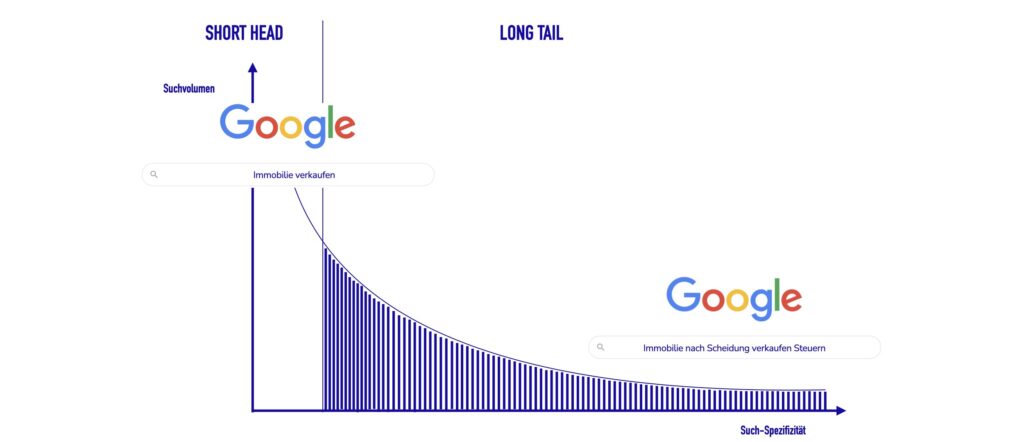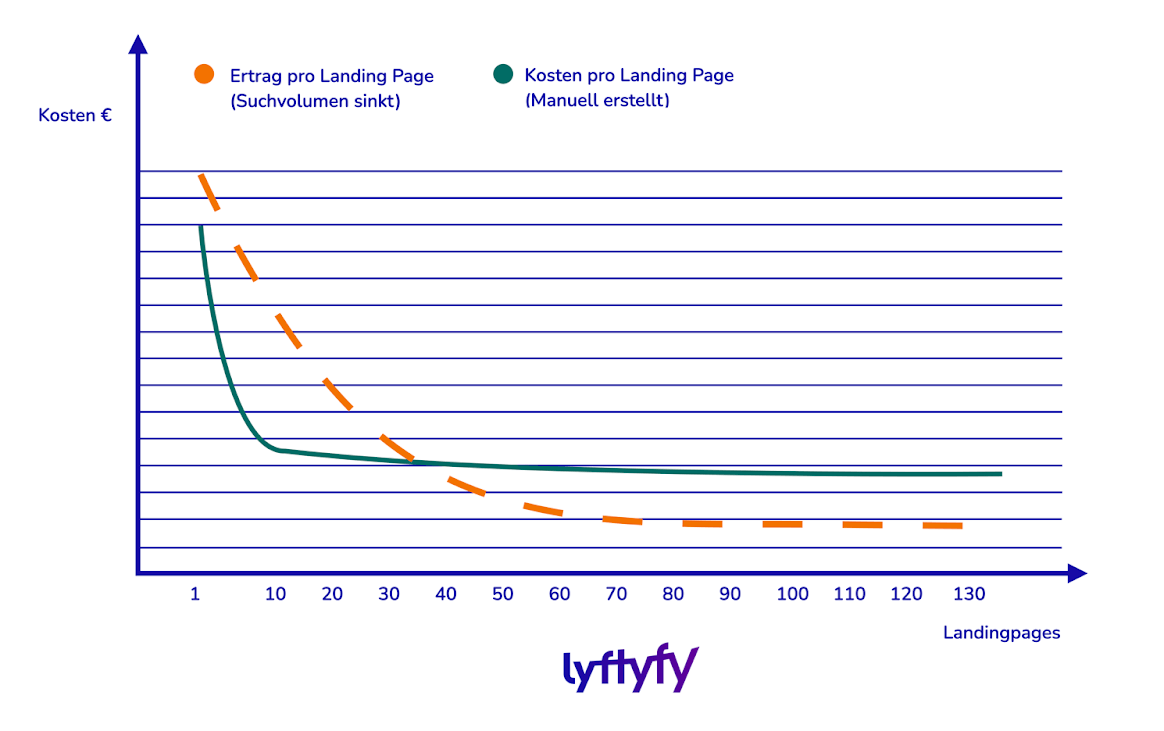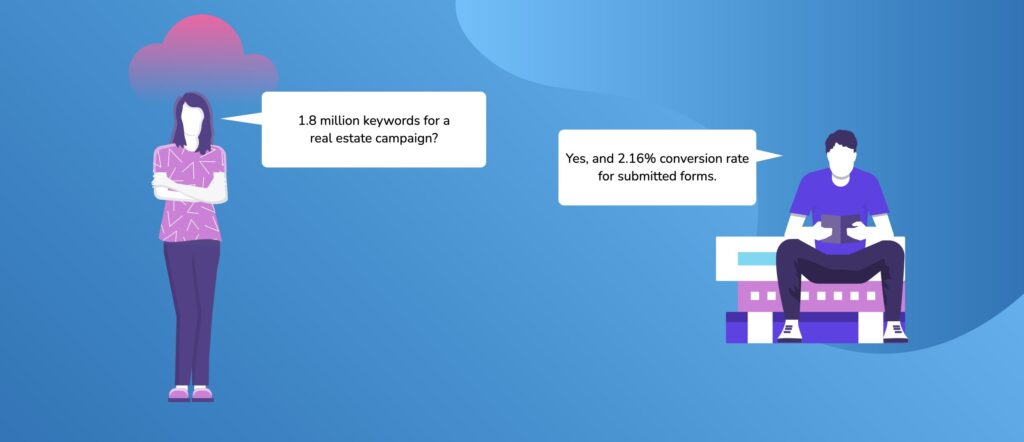
How To Set Up Long Tail Campaigns In Google Ads
The challenge
At some point, every SEA professional faces the task of tapping into the so-called long tail in campaigns. The reasons for this are obvious. On the one hand, one hopes to escape the highly competitive keywords that everyone else is also bidding on. On the other hand, longer-chain search terms are more specific – ideally, they reveal the search intent more precisely. That’s pretty critical to campaign performance.
At what point these projects are regularly abandoned or fail is partly due to how one defines longtail. Does one really mean the untapped endless expanses (as in Star Trek) of millions and millions of potential search terms and combinations? Or does one understand it – already somewhat more modestly – rather longtail-ish with perhaps a few dozen or hundreds of search terms?
Here, the bottleneck is the landing pages. If they do not match the ad exactly, the so-called quality score suffers. As a result, the ad is placed only rarely, with a hefty price surcharge or not at all. The effort for the additional ads is a waste of time.
An example: We want to advertise a “Short cocktail dress size 38”, but our landing page just says we have “Great dresses for summer”.
The bottleneck is the landing pages.
A cost-benefit calculation shows the limits of where the long tail ends in practical application and the real long tail begins. After all, it’s clear – we don’t sell that many cocktail dresses to make the effort for our own landing page worthwhile. So we leave it at “dresses” in the campaign. It gets even crazier when we consider creating separate ads and landing pages not only for size 38, but also for all other sizes.

The upper chart shows why long-tail campaigns usually end up in the lower double digits – the return on invest in fine-tuned granular measures (orange) is, after a certain point, lower than the (almost) constant effort for manually matching ad-landing page pairs (green).
Will keyword placeholders let us take the dive into the long tail?
And what about “smart” ads that automatically match ad titles to the search term – using so-called keyword placeholders? That way, after all, we’re automatically placing ads in the long tail, and what the searcher or searchers enter in detail is no longer something we have to worry about, is it?
The variable with the syntax {keyword:dress} would actually also trigger an ad in our case if someone searches “short cocktail dress size 38”. Unfortunately, however, Google would only display a generic abbreviated version of the ad here, which is, for example, texted like this: “Buy beautiful dresses”. This is because the actual search text is too long for the keyword placeholder and the ad.
Oh yes, and our response to the very specific search for a short cocktail dress, size 38 unfortunately remains completely non-specific here as well – both in the ad and even more so on the landing page, which also only generally advertises dresses.
What about Google’s long-tail aversion?
Many SEA professionals know the phenomenon: you create a campaign that goes a little further into the long tail – but Google only triggers ads for keywords from the short head. How does that happen?
The reasons can be many, managing and implementing auction events in real time may be easier with fewer keywords, and even seemingly mundane reasons like storage space could play a role. More obvious, however, are other reasons rooted in Google’s business model.
Google makes its money from auction battles for coveted search terms. Advertisers who have a high maximum bid ready are more likely to get to the top ad ranks for the same relevance. All others are placed less often, or have to settle for the ad ranks at the bottom of the page.
The total of all long-tail search terms is theoretically as large as in the short head.
This changes fundamentally as soon as we bid on rarer search terms in the long tail. Often enough, we are one of the few bidders here, and we place an ad that is not only favorable, but ideally also appears at the top. Sure, even then we’re often still surrounded by ads because they’re set to “broad match,” but they’re also significantly more irrelevant.
It is clear that in a situation with hundreds or even thousands of keywords, Google prefers those that most reliably exhaust the daily budget. And according to the statistics of normal distribution, these are the keywords with the highest search volume, i.e. from the short head. Long-tail search terms are then often not even activated with reference to “low search volume”.
Segmentation against low search volume
As true as it is that the long-tail search volume is considerably lower than that in the short head – normal distribution also comes into play here – it is still appealing to appear there. The reasons have already been mentioned: Clearer search intent, less competition, and typically strong performance on metrics like click-through rate and conversion. In addition, the total volume of all long-tail search terms is theoretically just as large as that in the short head.
15 percent of all search terms per day have never been searched for before.
Google itself mentions in a blog post that 15 percent of all search terms per day have never been searched before. This 15% niche alone has “low search volume” by definition. The long-tail market is huge – and largely unexplored. But we can change that with tools like lyftyfy.
It turns out that an interesting effect occurs when we create campaigns that consist exclusively of low search volume keywords. Since these campaigns also have a daily budget, Google is forced to activate the ads in them. And lo and behold – within days, hundreds of keywords are listed that triggered ads, often with single-digit search volumes. And not infrequently with 100 percent CTR.
To do this, we run an extensive campaign (with lyftyfy, it’s easily possible to get into the millions) and let it run for a period of time in classic click optimization mode. After one or two weeks we know where our usual short-head top performers are and what Google has left so far. The second part can be filtered by low search volume and outsourced to a separate campaign.
Depending on how much of the total budget the daily budget for our new segment turns out to be, Google will start serving these ads. The “low search volume” segment takes on a new life of its own, tapping into parts of the long tail.
So, over time, keywords from low search volume become those with higher search volume. For this strategy to succeed in the long run, the segments need to be regularly cleaned up and re-sorted.
Conclusion
Long-tail campaigns have suffered from a stigma to this day: too expensive, too much trouble, the return is less than the effort. And if we do the work anyway, Google ignores our efforts as well.
All that is a thing of the past. With the long-tail platform lyftyfy, it is possible for the first time to generate millions of ads and matching landing pages with the same effort with which we previously got just a few dozen. With dynamic segmentation, Google also activates rarer search terms.
The promise of the high-performing long-tail campaign, it’s finally here – for everyone.
Are you curious? Request a free demo now!
lyftyfy opens a door to the world of informational search queries that has never existed before. Create your own, perfectly tailored thematic worlds for every type of user today. It’s as exciting as it is complex. If you are interested, we would be happy to present our tool to you in more detail – perhaps even with a concrete case study that is relevant to you.


